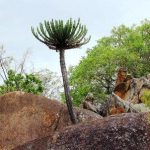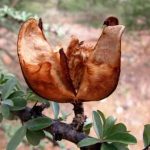TREE LIFE
NOVEMBER 1991
MASHONALAND CALENDAR
Tuesday 5th November: Botanic Garden walk at 4.45 for 5 pm. Park at the Herbarium where we will meet Mr Tom Muller.
Sunday 17th November: The ‘Meadows’ on the Mutoko Road is this month’s venue. Mr David Simleit has invited us to spend what promises to be a very interesting day on his Farm. There is, on the Farm, a ‘mystree’ which we’re invited to try to identify, and in the afternoon David might be persuaded to divulge a few wine making secrets.
Saturday 23rd November: Walk with Mark in the Mukuvisi Woodlands. Meet in the main car park at 3 pm.
Tuesday 3rd December: Botanic Garden Walk.
The date and venue for our Christmas outing/social has not yet been finalised – perhaps in the picturesque Goromonzi area.
No walk with Mark in December.
MATABELELAND CALENDAR
Sunday 3rd November 1991: A new area 75 Km out to (and beyond) Nyamandhlovu – all on tar, with about 3 Km on to the Glencurragh Farm. Mr wood is quite proud of the amount of trees on his 1400 acre farm which ranges from Kalahari sand to rocky kopjes – he will be joining us and then we can eat our lunch on a civilized verandah Varanda (with ice). Keep fingers crossed for leaves as they have had some rain. All day outing — bring tea/lunch/chairs. Meet at Falls Road Motors at 8.30 am.
Wednesday 13th November 1991: McHEW at Hillside Dams – 5.00 pm.
Sunday 1st December: Again out on the Falls Road – but a morning outing to Mguza Nature Reserve (15 Km) where quite a lot of development has taken place since our last visit. While looking at trees we might trip over a giraffe, tseseebe, zebra, kuiu, impala or two, but there should be water in the Lower Mguza dam to support the tree life and the views are quite impressive. Meet at Falls Road Motors at 8.30 am. complete with tea-time and chairs.
Wednesday 18th December 1991: The last McHEW of the year at Hillside Dams at 5.00 pm.
Before the New Year’s party at the Blakes’ to herald in 1991 – Angie Murray has her thinking cap on already to co-ordinate the food – be nice to her.
BOTANIC GARDEN WALK – OCTOBER 1ST
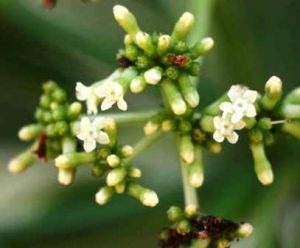
Rauvolfia caffra. Photo: Bart Wursten. Source: Flora of Zimbabwe
This month we looked at trees in flower. Craibia brevicaudata (PAPILIONOIDEAE) was covered with white flowers, (slightly pink tinged; and had the usual fluffy white aphids. The flowers are usually only seen at the top of the forest canopy. The neighbouring Rauvolfia caffra (APOCYNACEAE) was also in flower, tiny white flowers in huge heads. They are sweet scented and attract insects. Rauvolfia resembles Breonadia microcsphala (RUBIACEAE) which also grow in the Eastern districts.
Phyllanthus inflatus (EUPHORBIACEAE), a Chirinda forest under storey species, had small white flowers and green fruit on it. This has branches which at first glance resemble compound leaves, yet as the number of “leaflets” is very variable they are obviously simple leaves not leaflets.
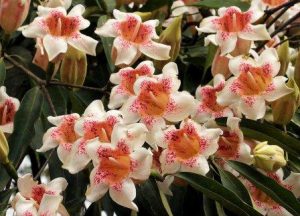
Rothmania manganjae. Photo: Bart Wursten. Source: Flora of Zimbabwe
Rothmania manganjae and R.urcelliformis (RUBIACEAE) were coming to the end of their flowering season, but the remaining cream and purple bells still smelt beautiful. R.urcelliformis has huge fruit (up to 7 cm in diameter) which take 2 years to ripen. Vangueria esculanta (RUBIACEAE) is a forest species from the Eastern highlands, with soft furry leaves. The other Vanguaria from the same area, V.apiculata has shiny green smooth leaves and is known as the tangle-flowered wild medlar as the calyx lobes of the tightly bunched flowers do seem to tangle up. In passing we noted Argomuellera macrophylla (EUPHORBIACEAE) – another Chirinda under storey shrub, Tabernaemontana ventricosa (APOCYNACEAE) and Albizia gummifera (MIMOSOIDEAE) Rinorea VIOLACEAE has flowers which are small cream bells resembling those of Lily of the Valley. The species we looked at, is another under storey shrub from the lower Vumba and Chirinda Forests.
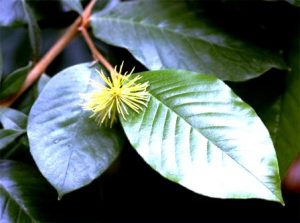
Trichocladus ellipticus. Photo: Bart Wursten. Source: Flora of Zimbabwe
The Flowers on Trichocladus ellipticus (HAMAMELIDACEAE) – the witch hazel, were just over but they usually have a magnificent perfume.
In the last of the light we admired two spectacular trees, the Stereospermum kunthianum (BIGNONIACEAE) in the lowveld section, flowering as never before, and Combretum paniculatum which was a blaze of colour.
-Tessa Ball
MATABELELAND NOTES
On Sunday, October 6th, we went to Val Degas’ house in Matsheumhlope. As her access to the Bush Area has been blocked, we then went round to the Circular Drive, to the part opposite the West. Trees were very dry, and it was very hot SO most sensibly we only Treed for a couple of hours or so, and it was well worth while, but enough. It became quite a matter of Detective work. In all we identified 61 species, but, undoubtedly, many more went unrecognised.
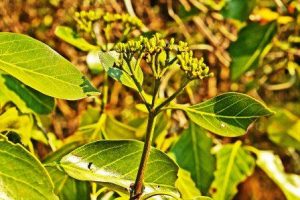
Tarenna zimbabwensis. Photo: Meg Coates Palgrave. Source: Flora of Zimbabwe
Acacias were : A. karroo, A. nilotica, A. rehmanniana, Albizia amara, A. antunesiana. Azanza garckeana, Bolusanthus speciosus, all green, in new leaf, indeed, those on the City’s roads have flowered very well this year. Burkea africana, very dry, though some fruiting, Carissa edulis, very green, as was Cassine matabelica – some with the largest leaves I have ever seen on that species, Cissus cornifolia, all in bud, 3 Combretum : C. apiculatum, C. hereroense, C. molle, Commiphora mollis, C. schimperi,(presumably) Cussonia arborea, C. natalensis, quite a few Diplorhynchus condylocarpon, Erythrina latissima, Faurea saligna, some with very red new leaf, of figs only Ficus glumosa, F.ingens, Flacourtia indica, very dry and thorny, Maytenus senegalensis, M. undata, with exceptionally small leaves, Olea europea, the local African subspecies, one of the most notable evergreens, Ormocarpum trichocarpum, with a thick corky stem. Osyris lancelolata, often a root-parasite of figs, perhaps not always, as there were not many of these, many young Ozoroa insignia a few very small Pappea capensis, Pavetta schumanniana, at first only recognised by its thick leaves, many Schrebera alata, including one that could be called S. alba, as it had dried quite white. Securidaca longepedunculata, the Violet Tree, Strychnos spinosa, the only Strychnos, Tapiphyllun velutinun, with its red under bark, Tarchonanthus camphoratus, still showing some white, Tarenna zimbabwensis, Tetradenia brevispicata, very dry, Turraea nilotica just budding, many Ximenia caffra, also a good sized trunk of Zanthoxylum capense.
-C. SYKES
OCTOBER MCHEW
Surprise, surprise, we needed anoraks in October – and that wasn’t the end of our worries,- as, when Ian handed out the photo-copies this month, they were examination papers – about Figs – of course we all know about figs, until we are asked questions: After pugatory, Ian was very kind and only asked down to l3 out of 20 answers. Predictably Charles won the largest bar of chocolate, followed by Margaret and Jill!
As a sop to our feelings we then went off to see some more figs – Ficus sur and its many offspring, a free-standing F. thonningii and a rock splitter F. ingens. And then a discussion ensued about a baby F. ingens climbing out of a rock fissure, and all its food requirements in such an inhospitable place.
For me the second half was better than the first . . . thank you once again, Ian, maybe its better that I didn’t win the chocolate.
-KEN BLAKE
Good management I am told requires a business to operate within fixed and acceptable rules and yet retain flexibility. Our Tree Society has evolved in this way. We have a flexible system of branches, offshoots and splinter groups. Now I am pleased to report we have an organisational “twig” at Fairways Homes in Eastlea. Mrs Barbara Tunney runs this twig and keeps her eyes on some mature indigenous vegetation and some re-generation.
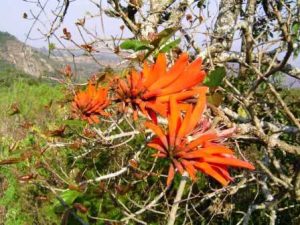
Erythrina lysistemon. Photo: Bart Wursten. Source: Flora of Zimbabwe
I finally accepted a long standing invitation to go and visit there. I could not have gone at a better time, the Erythrina lysistemon was in full flower and beautiful. Barbara was instrumental in saving the life of this tree a few years ago when she pointed out to Mr Bell, the Secretary/Manager, that it was being smothered by Bougainvilliea.
Nearby is a promising young Celtis africana five metres high. Barbara is modest about this one, but I happen to know her role here also, she pointed to the seedling out to the gardeners, thus saving its life as a baby, newly bird spread she has lovingly encouraged it to grow since then. Also flourishing in the garden, also probably bird-spread are : Rhus lancea, Ficus lutea and Phoenix reclinata. Planted Trichilia and Tetradenia riparia add a touch of indigenous class. The whole effect is of a carefully tended garden which containing as it does indigenous flora, shows that a wall manicured garden can also cater for nature as well as being a pleasing place to walk and sit.
Situated where this garden is on the right bank of the Chiripangura river, I think it may be classified as uburban highveld riverine regeneration.
Thank you Barbara for a sterling conservation job.
Published with acknowledgement to Fairways Homes, Eastlea.
-George Hall
NOTES on TAXONOMY (continued)
What happened to the lovely neat order of tree and herbarium numbers when for example, a tree is moved from one genus to another or more commonly, given a new species name? This latter seems to happen infuriatingly often and just when one has succeeded in getting the old name firmly committed to memory.
– when a specific name changes it keeps its old National Tree List number. eg. Ochna oconnorii changed to O. arborea and kept its number of 703, even though this puts it out of alphabetical order.
– when a new species is added to a genus, it is inserted in its correct alphabetical order and a new National Tree List number allocated to it. eg. when Neorosea jasminiflora changed to Trichalysia jasminiflora it fitted between T. congesta 1086 and T. junodii 1087 and took the new number 1086/l.
– when there is a move of a complete genus in the Engler and Prantl system there is a change in its Herbarium number too. A look through Mr R B Drummond’s publication of 1975 (see below) shows that between Vanguria 8351 and Canthium 8352 has been added Tapiphyllum 8351C: and Vangueriopsis 8351E. These were obviously moved at some time from elsewhere (where?) and slotted in here.
– So, numbers after the slash for species, letters for genera, when a tree is renamed or “translocated”.
why change names at all? why move things around?
There is a constant appraisal of specific names, and changes are made for various reasons, most often in an effort to standardise them. For example, naming after the person who first discovered the tree or after the place where it was first found. Also botanical terms are preferred to those of a general nature. A shame really : I rather liked the old Jove’s thunderbolt of Gardenia jovis-tonantis now more botanically Gardenia ternifolia.
Less commonly a tree name may change from one genus to another. I had imagined a committee of botanists who would meet to debate, decide and decree on such matters: “from now on Acacia albida will be known as . . . etc. etc. ” Not so, or at at least not often, for these panels do exist, and not just in Botany. Virology, a much newer science with new viruses being discovered at every turn, has an International Committee on the Taxonomy of Viruses. With the plants, more usually someone working on a genus will decide that it should be moved in the schema of things and then, presumably depending on their scientific standing and the worth of their published work, their recommendations will be accepted or rejected by other botanists – sooner or later. An example of this is seen with some of the Canthiums which have been placed in other genera. Canthiun huillense to Psydrax livida; C. bibracteatum to Pyrostria bibracteata; C. venosum to Keetia venosum.
This is a result of work being done on Canthiums at Kew by Bernard Verdcourt and Diane Brideon (thanks to Mark Hyde for this information).
Erratum last month: herbarium numbers refer only to the list of genera.
References :
A List of Trees, Shrubs and woody Climbers Indigenous or Naturalised in Rhodesia.
Separate from KIRKIA Vol. lD Part 1 (1975) Dept of Printing and Stationery, Salisbury.
For the 1981 National Tree List see Robert B. Drummond. Common Trees of the
Central Watershed Woodlands of Zimbabwe. NRB.
NAMIBIA TRIP – AUGUST 1991
We entered Namibia via the Caprivi Strip — hours and hours of travelling on a dead straight, dusty, white, dirt road, the dust so fine it was like talcum powder. We camped for the night at Popa Falls, a beautiful rest camp on the Okavango River. There were walkways across the rivulets; lush vegetation and the continuel sound of the rapids. I was tickled to find Myrica serrata here – on the distribution map Coates Palgrave has a dot at the end of the Caprivi strip.
Then came a day’s unscheduled stay in Grootfontein while U bolts were being replaced on the landrover. It is a friendly, unpretentious town which reminded me of Mutare and I wouldn’t mind living there. The largest meteorite in the world, Hobs meteorite is 19 Km outside the town. I imagined something the size of a two storey house. It is actually about 3 metres in diameter, a meter high and weighs about 50 tons (62% iron, 16% nickel) where a corner has been polished it looks like stainless steel. Thanks to the tree list at the site I became acquainted with Acacia hereroensis and A. reficies – the false umbrella thorn. Except for the pods, the latter is similar to A. tortilis. At Namutoni camp in Etosha they grew side by side and it was a challenge trying to differentiate them on the basis of the bark. In the same camp were Lonchocarpus nelsii covered in pods – the book describes them as being finely velvety and they do feel just like shammy leather.
In places, Etosha was a yellow sea of flowering Acacia nebrownii, and the scent would travel with us. We watched Kudu eating the nebrownii twigs.
Black-faced impala, red hartebeest and gemsbok were new animals for me. I have never seen such herds waiting their turn to drink at a water hole. There would be elephant or giraffe at the water and then zebra, kudu, gemsbok and wave after wave of impala standing by with hours of the day taken up this way I wonder that they have enough feeding time.
There are a few distinctive black rock kopjes projecting above the Etosha plain and on these grow Moringa ovalifolia. Without their leaves, they look a little like baobabs -and the locals have a similar theory, that God planted them upside down. In one section of the park they form what is known as the ghost forest, presumably because of their silvery white bark.
South of Etosha we visited the petrified forest, – huge, petrified logs (one is nearly 30 metres long). They were apparently deposited by some cataclysmic event and are so “well preserved” that bark, knots and annual rings are all clearly visible.
-Tessa Ball To be continued
We have a spare page this month so I’m sure members would like to share a little of‘ Kim and Cécilo’s recent wedding. Following Danish tradition these verses were composed by Dhil and sung by the guests at the wedding to the tune of the old Yorkshire Folk song “On Ilkley Moor Bar T’at.” ‘
N.B. ‘Shambles’ is the name of‘ the Haxens’ property.
“where was Cecile when she met Kim? she met Kimon Shambles Greenish Grass,
where was Cecile when she met Kim?
Where was Cecile when she met Kim?
On Shambles Greenish Grass
On Shambles Greenish Grass
was where it came to pass.
He’d come from Cape Town to U Z. to U Z
To Fill some facts and figures in his head
He’d come from Cape Town to U Z
He’d come from Cape Town to U Z
’ For academics he said
For academics he said
with no intent to wed
she’d come to Africa looking for oil, looking for oil
And to see some buck and trees on Zimbo soil
She’d come to Africa looking for oil
She’d come to Africa looking For all
Not for a Gentleman loyal
Not For a Gentleman loyal
‘Twas merely For the oil
I’d been to Mukuvisi Park, ‘Vlei Park
To show the tourists game from Noah’s Ark
I’d been to Mukuvisi Park
I’d been to Mukuvisi Park
‘ One drizzly Easter morn
One drizzly Easter morn
An Antlion or Aardvark
No tourists came until at last, til at last
A Rixi Taxi (blue) roared in quite fast
But stepped Cecile to View the woods
Out stepped Cecile to view the woods
Thinks I, Kim’ll like these ‘goods’
Thinks I, Kim’ll like these ‘goods’
From then the die was cast
Took her home for tea upon the grass, ‘pon the grass
Then Kim stopped by for coffee or a glass
Love began to germinate that day
Love began to germinate that day
Baobab – like it grew
Yes Baobab – like it grew
Slow, but sure, on Shambles grass
Now there’s a wedding on the lawn, on the lawn
we celebrate the dawning of the morn
when this bot/zoo/ecologist
weds with a geophysicist
what else may come to pass
From meeting on this grass?
On Shambles Greenieh Grass.
0‘.
KIM DAMSTRA CHAIRMAN


